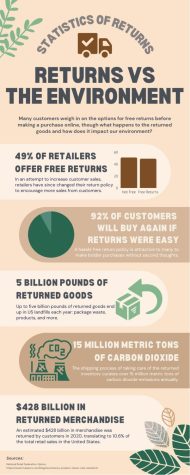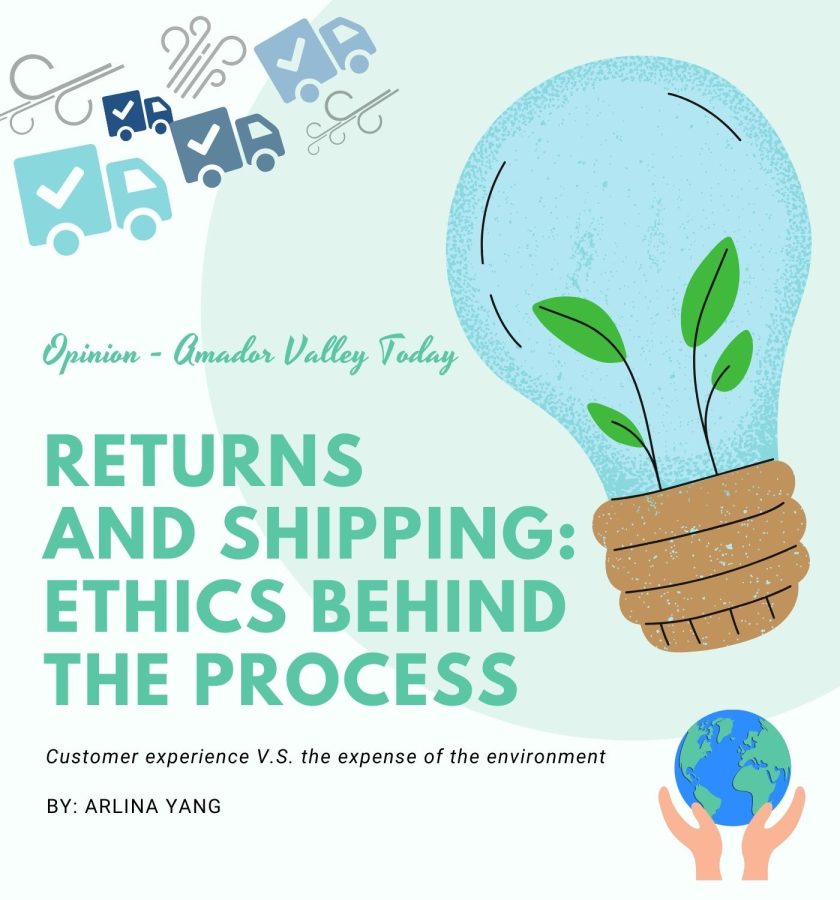Returns and shipping: ethics behind the process
There has been some debate over the ethical process behind returns and shipping at the expense of customer experience and the environment.
February 21, 2022
The cost of returns and shipping have only seen exponential growth with the dramatic increase in online shopping due to the pandemic. The National Retail Federation additionally reports that an estimated $428 billion in merchandise was returned by customers last year in 2020, which is also translated to 10.6% of the total retail sales in the United States.
While the option for returns being offered to consumers is always preferable, it is not always the easiest process for companies. Though what happens to the returned products that giant corporations receive on a daily basis?
The effects that the process of returns and shipping has on Earth inevitably outweighs the return options offered to customers.
The Effects
Every returned package from consumers results in a trail of emissions in addition to the original trail it had left to arrive in the hands of the customers. From truck carriers, trains, and planes, pollution gradually builds up to contribute to the grand issue at hand—climate change.
“In my experience, H&M and Aerie have great return policies – it was super easy for me to exchange or refund items. But overall, the kind of store you’re buying from and what merchandise you bought really determine how easy the process is. Customers should definitely have a return option – in case they ever change their mind about a product,” said Tho Nguyen (‘23).
Through the increase in shopping online that came with the pandemic, online retailers face a whopping return rate of over 20% while their counterparts of in-person stores have a rate of 9% (RetailDive). Many retailers have additionally created sizing quizzes, detailed product descriptions, or customer service bots to minimize return rates and to avoid common reasons for returns such as wrong sizes.
“Returns are obviously great to have as an option for customers, but with climate change already spiraling out of control due to other factors of pollution, free return policies aren’t exactly environmentally friendly. It’s only pushing the limit for how fast the rate of climate change can speed up even more,” said Andrea Yang (‘23).
Not only does the return process contribute to pollution, the effects to process the immense extent of wasted products equally racks up to a considerable amount of pollution.
The Growing Rise in Cost

Often the returned items end up at landfills or in the hands of liquidators due to the fact that sometimes it’s simply the most cost-effective way for companies to process the returns rather than cleaning the product to go back onto the shelves.
Around five billion pounds of returned goods end up in US landfills each year, with the shipping process of returned inventory creating over 15 million metric tons of carbon dioxide emissions created annually (Optoro).
“I have definitely returned something I bought, but I never knew about where they go until now. I think both (customer experience & the environment) are important but at the moment, maybe the environment should be more valued, but also, I think that if a company creates a separate store, or something of that essence, for selling returned goods, that might be a good solution too,” said Handson Li (‘23).
Regardless of the expected norm for free returns, paying a small fee similar to the cost of a cup of coffee more or less would be better than offering entirely free returns. The fee could allow for more responsible processing of the returned products all whilst being more conscious of the environment.
“It’s extra effort for not only the companies to take care of the returned products, but retailers at the same time want customers to make big purchases without having to think of the hassle for returns. Though at the same time, it’s also allowing for the customers to make fast purchase decisions without checking the details, which is good for companies saleswise, but not good environment wise for the increase in returns,” said Yang.
Similar to the California Bottle Bill of an extra $0.05 or $0.10 paid by the consumer depending on the size of beverage containers, many would understand the small return cost if it means to reduce the problem of climate change for the environment. The return fee would be measured on the number of items or the combined weight of all the items, though the cost shouldn’t be more than the original shipping cost.
Due to the damage to the environment that resulted from the increase in returns and shipping through the growing simplicity of the return procedures and online shopping, the process needs to change. A small cost for returns and shipping can incentivize consumers to shop responsibly all whilst protecting the environment.





